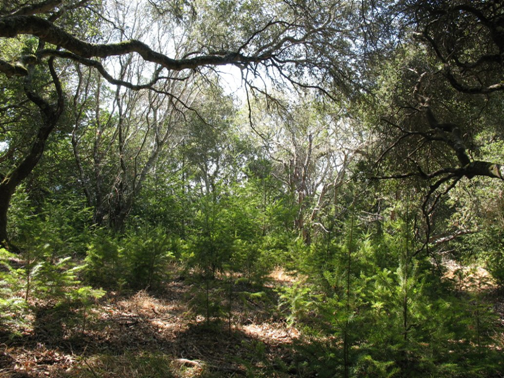
As SOD-related mortality increases, a landowner or manager may wonder what, if any, actions they should take to restore forest canopy cover. Appropriate options for forest restoration can be identified for individual stands based on stand conditions and management goals. This can be done by following the adaptive management process discussed above (fig. 2-1).
Although tree mortality due to SOD will cause a loss in tree density (trees per unit area), mortality does not always reduce overall canopy cover. In well-stocked forests that have overlapping tree canopies and include species that are not SOD canker hosts, small canopy gaps may be quickly erased by canopy expansion of nonsusceptible canopy species or growth of understory trees.
Some tree mortality in a dense stand may not be detrimental. Reduced tree density may reduce competition for moisture and/or light within the stand and improve growing conditions for remaining trees.
In contrast, mortality of dominant trees in relatively open stands will typically cause significant changes in canopy cover and forest structure. As canopy cover loss due to SOD increases, valuable ecosystem services (table 2-1) are likely to be reduced or lost.
Even small losses of canopy cover can have disproportionately large impacts if they affect critical areas or involve unique resources. For example, acorns produced by oaks and tanoaks can contribute significantly to wildlife habitat value, even if these trees make up a small percentage of the stand. When evaluating the need for restoration in SOD-affected forests, consider both effects on overall canopy cover and ecosystem services that are not strictly related to canopy cover loss.
Assess the size and distribution of canopy gaps created by tree mortality and failure. Canopy gaps represent opportunities for natural or assisted regeneration. Canopy gaps can also provide habitat elements that are absent in closed-canopy forests, which can benefit some wildlife species and increase overall biodiversity.
As noted above (see Sidebar 2-2—Disease, Damage, and Mortality Related to Other Agents) P. ramorum canker is not the only mortality agent that needs to be considered when assessing restoration needs. If other mortality agents are active in SOD-affected forests, mortality can affect a wider range of species and a greater percentage of the total forest canopy. This can further complicate prospects for restoring a functional forest.
Most SOD affected forests contain understory regeneration (seedlings and saplings) of various tree species. Understory regeneration may include both current canopy species and trees not found in the overstory, but oak seedlings may be uncommon even under an oak overstory. California black oak seedlings are often rare (Swiecki and Bernhardt 2008d). Seedlings of coast live oak vary widely in number from year to year and between locations (Swiecki and Bernhardt 2008a). Established understory seedlings and saplings in SOD-related canopy gaps can be an important source of regeneration. When released from the suppressive effects of overstory competition, these persistent seedlings and saplings commonly show rapid growth (fig. 2-5).
Gaps may also be colonized by species that do not establish well under canopy. Both shade-intolerant native species and many weedy exotic species may be favored by canopy gaps. Weedy species may suppress natural regeneration of preferred native species by competing for soil moisture and other resources. If aggressive exotics such as broom species are present in or near the site (fig. 2-6), additional management may be needed to suppress exotics and favor desired native species.
After evaluating what you have in terms of mortality and natural regeneration, you will need to decide what you want to achieve in terms of forest structure and function. If SOD impacts are limited, no active restoration activities may be needed to maintain overall stand conditions. In other situations, relatively modest interventions made in a timely fashion may be sufficient to achieve a desirable outcome. In the most severely impacted stands, significant management inputs may be needed to restore lost ecosystem services or prevent undesirable changes in vegetation composition or structure.
Specific management actions needed to implement restoration goals will vary widely based on forest types, site conditions, landowner resources and capabilities, and other factors (see 3.5 Restoring SOD-Affected Forests and Sidebar 2-4—Restoration in Developed Versus Wildland Settings). The key to cost-effective restoration is determining what factors are likely to constrain regeneration at the site. Restoration inputs can then be selected to specifically address these site constraints. Monitoring the results of your restoration efforts will provide information needed to improve and optimize your methods (see 3.5.5 Monitoring Restoration Outcomes).
A mosaic of restoration approaches may be applied in different areas and implementation may be phased over a period of many years. Risks associated with unfavorable weather (e.g., drought) can be minimized if the implementation schedule is flexible. Timelines for projects with public funding may have less flexibility in the implementation schedule.

Figure 2-5—In many SOD affected sites without Douglas-fir overstory, dense Douglas fir seedling establishment occurs in canopy gaps that develop when overstory coast live oaks are killed by SOD. In these gaps, Douglas-fir can easily outcompete slower growing hardwood species.

Figure 2-6—Exotic French broom (Genista monspessulana) has become well established in the understory of this coast live oak stand, which has experienced long-term canopy thinning due to Phytophthora ramorum infection.